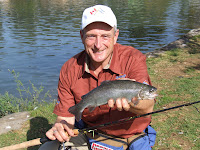I recently came across a great website that gives detailed fishing reports for fishing spots in Israel: www.fishinginisrael.info. Put together by Nigel Ridley, each article contains descriptions of the fishing spot along with pictures and maps of where to fish. Below are two of Nigel's articles, with many more to be found on his site. Enjoy! The Fly Fishing Rabbi
Saltwater Fishing Spot In Israel: Tel Dor
Saltwater Fishing Spot In Israel: Tel Dor
South of Haifa, the coastline from Kibbutz Nachsholim to just before the beach at Habonim (where you're not allowed to fish - it's a nature reserve) offers some very good rock and reef fishing. All along this stretch of coastline there is a submerged rock plateau. It is strangely flat and wide with a covering of sea water of about 10cm on a calm day. This plateau enables the angler to fish in deep water even right next to it's edge.
Further out there are reefs so bottom fishing is not really feasible but float fishing, spinning or fishing with crankbaits will certainly pay off with some good sized fish. There are quite a variety of fish species to be had from the smaller ones that inhabit the seaweed covered rocks to larger ones such as barracuda, little tunny, spotted seabass, members of the grouper family and others. The best times to fish though are, like most other places along the coast, around dawn and dusk when the larger fish move closer inshore from the deeper water.
Further out there are reefs so bottom fishing is not really feasible but float fishing, spinning or fishing with crankbaits will certainly pay off with some good sized fish. There are quite a variety of fish species to be had from the smaller ones that inhabit the seaweed covered rocks to larger ones such as barracuda, little tunny, spotted seabass, members of the grouper family and others. The best times to fish though are, like most other places along the coast, around dawn and dusk when the larger fish move closer inshore from the deeper water.
Just a word of warning: the submerged plateau is dotted with potholes here and there, so be careful where you are stepping especially in the dark. During the summer months it is not a problem standing in the water in a pair of sandals but if you intend fishing in when the water temperature is not so warm, then you will need a pair of waders at least.
Getting There
Turn off the Coastal Highway at the Zichron Ya'akov Interchange and turn left at the Faradis junction. Pass through Faradis and turn left towards Kibbutz Nachsholim immediately after leaving the village. About 3km down the road turn right towards the kibbutz entrance but keep going instead of actually turning left into the kibbutz. The road quickly turns into a dirt track. The track turns left at some fish farm buildings; turn left where you see a small sign marked 'Tel Aviv' pointing back at you. It looks as if there is no through road but it will take you to a small parking lot close to the beach (get there early - it fills up quick!). From there head to the beach and work your way south to the rocks and good fishing. You can also camp on the beach making it more convenient for dusk/dawn fishing. Talking about conveniences, there are none so be prepared to rough it a bit.
I've created a map on GoogleMaps so you can see how to get there.
Tight lines!
Freshwater Fishing Spot In Israel: Jordan Park (Park HaYarden)
Known locally as Park HaYarden, the Jordan Park offers a small quiet stretch of river for fishing. There are an abundance of small fish, some St. Peter's fish, carp and catfish. It's a great place for a family camping weekend with lots of things to do and trails to hike along. There is also 'Abu Kayak' where you can rent inflatable rafts and kayaks - a great way to explore the river for those hot fishing spots! You can also use it as a base for fishing trips to the Kinneret and the Jordan River, both of which are just a few kilometers away.
Getting There
If you are coming from the Tiberius direction then head north along Route 90 and then right onto Route 87. Continue past Capernaum (Kfar Nachum) for about 6km, passing over Arik Bridge as you go, and turn left onto Route 888 at the Beit Tsaida junction. You will see the entrance to the park on your left after about 1km. If you are coming from the eastern (Golan Heights) side of the Kinneret then head north along Route 92 and then bear left onto Route 87. Continue for about 1km and turn right onto Route 888 at the Beit Tsaida junction. You will see the entrance to the park on your left after about 1km.
Tight lines!
To read more about fishing in Israel on The Fly Fishing Rabbi, Click Here
Tight lines!
To read more about fishing in Israel on The Fly Fishing Rabbi, Click Here






































